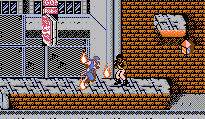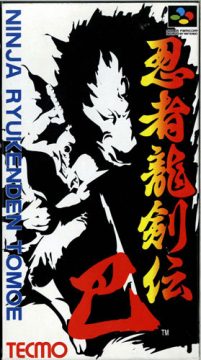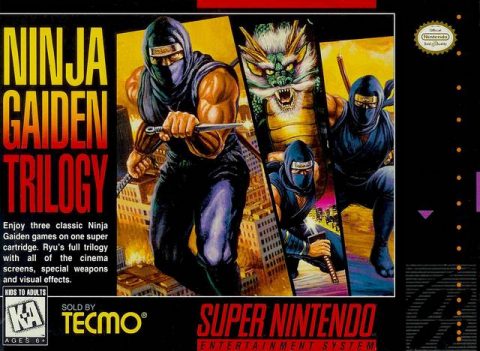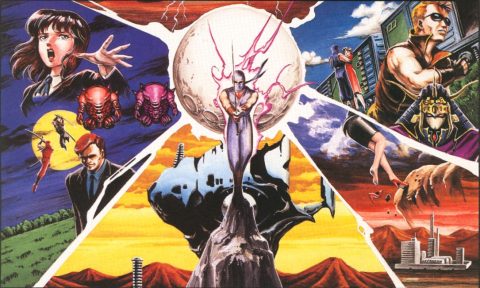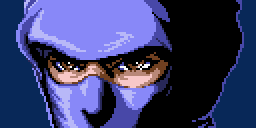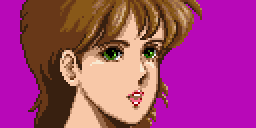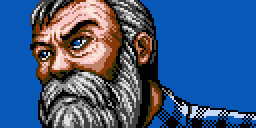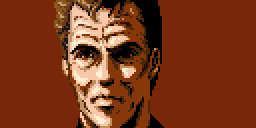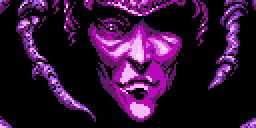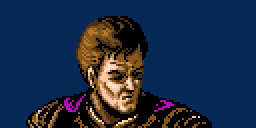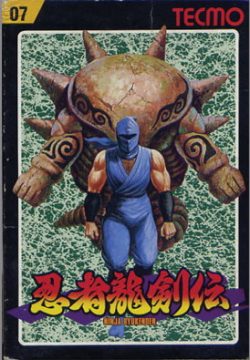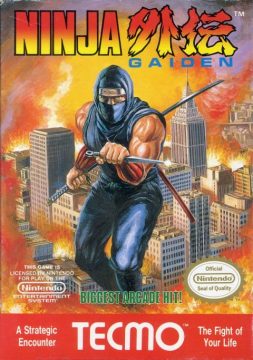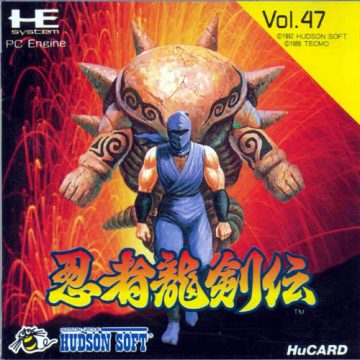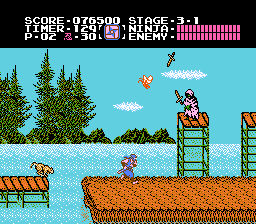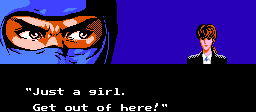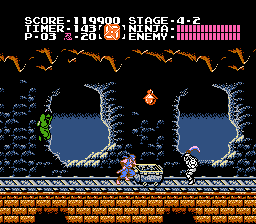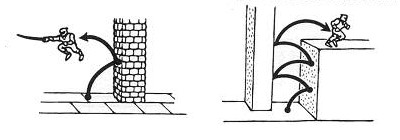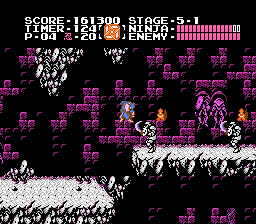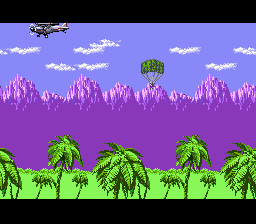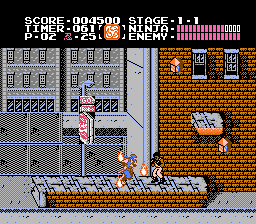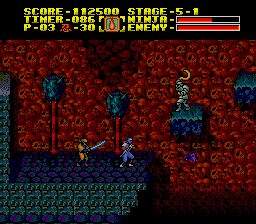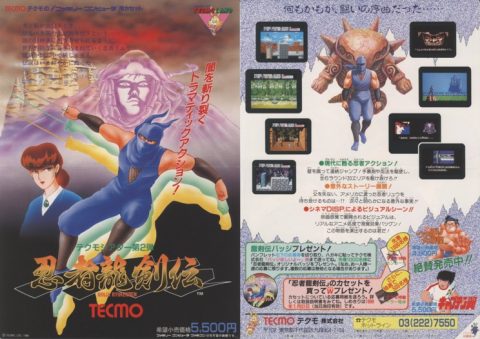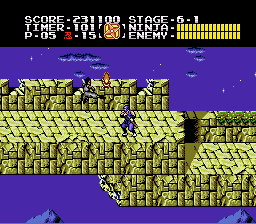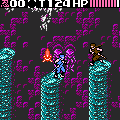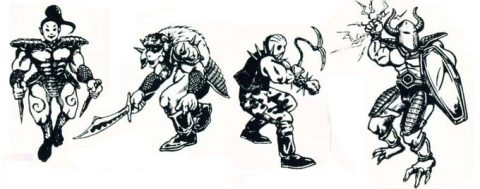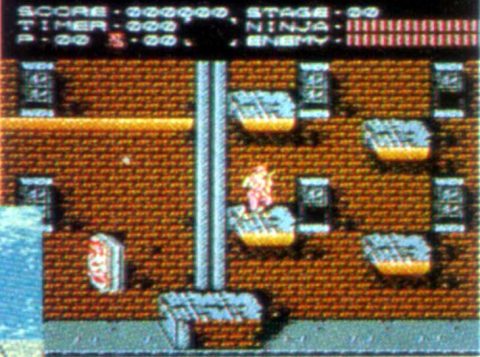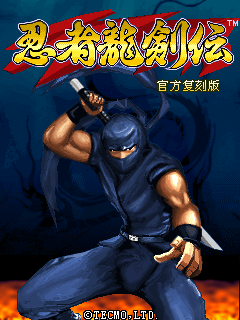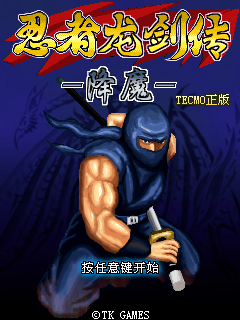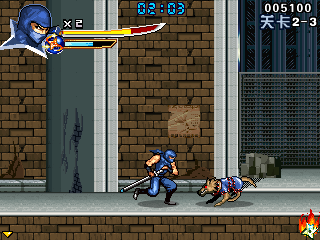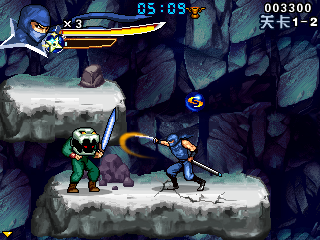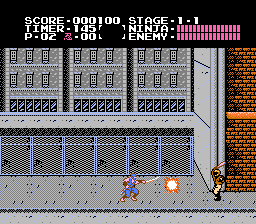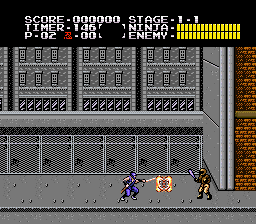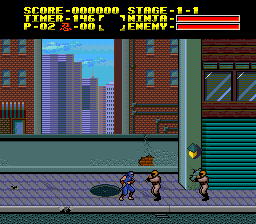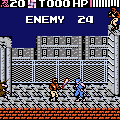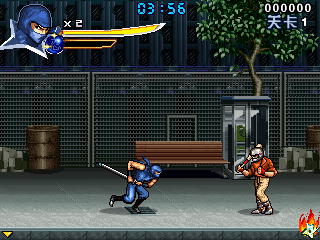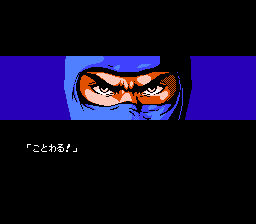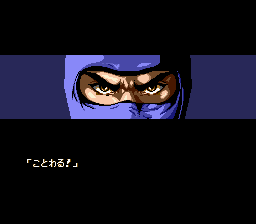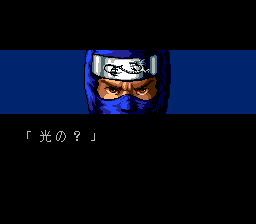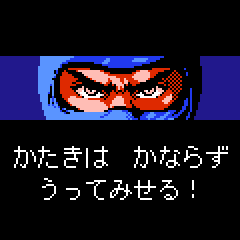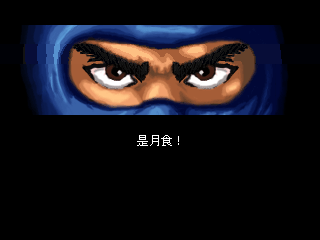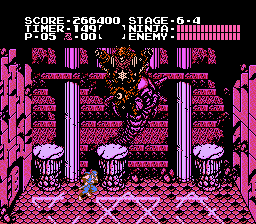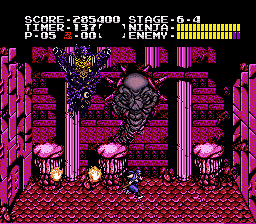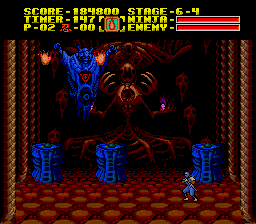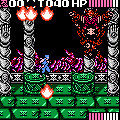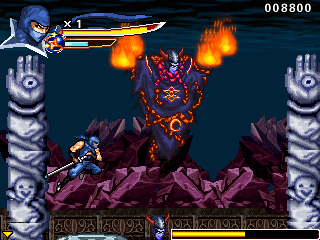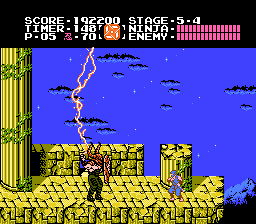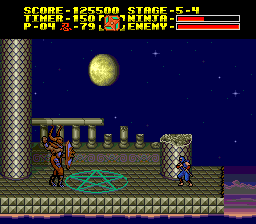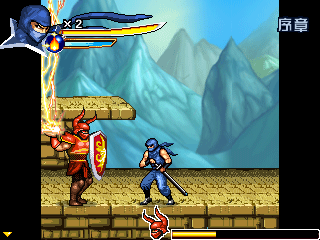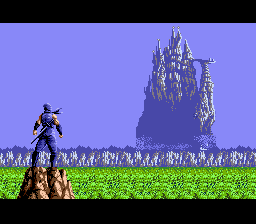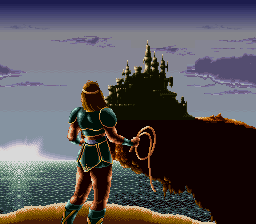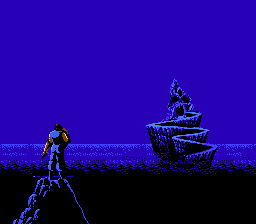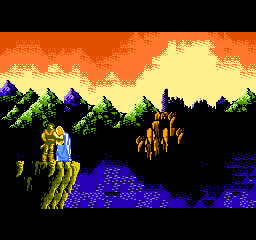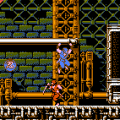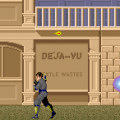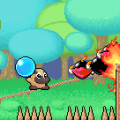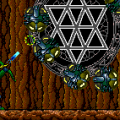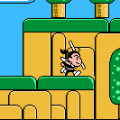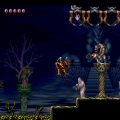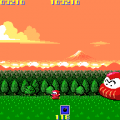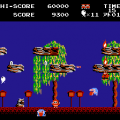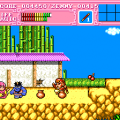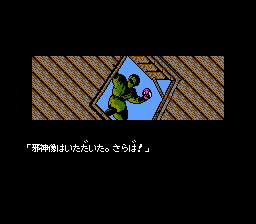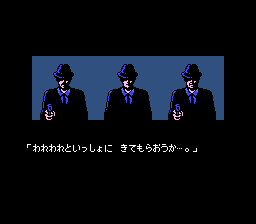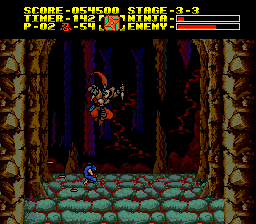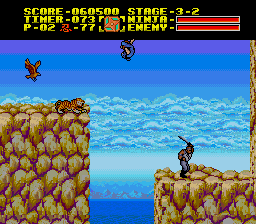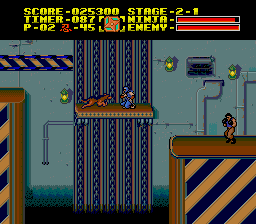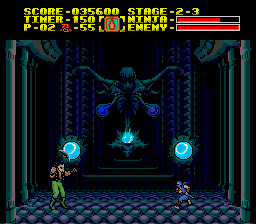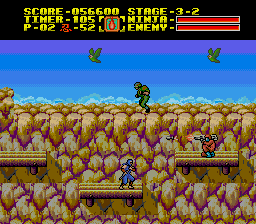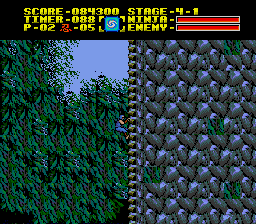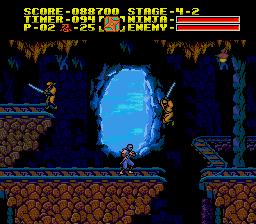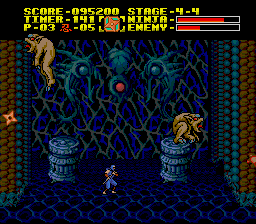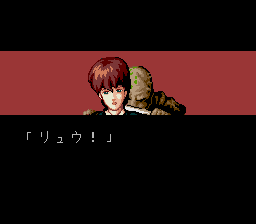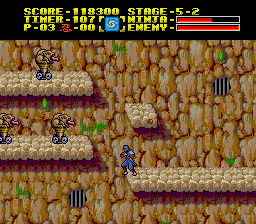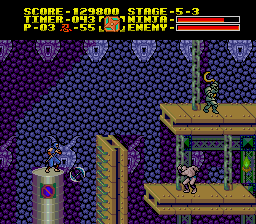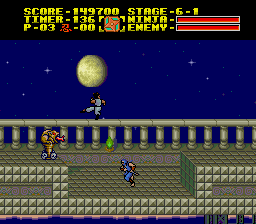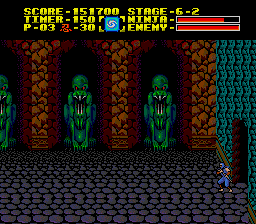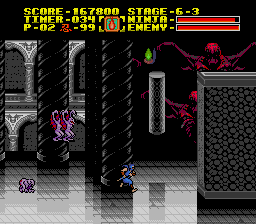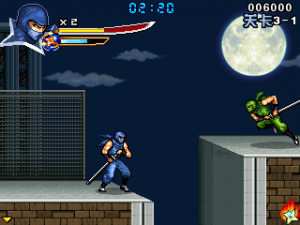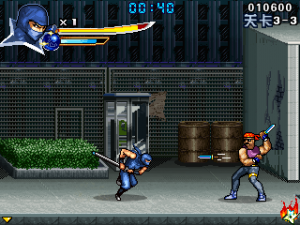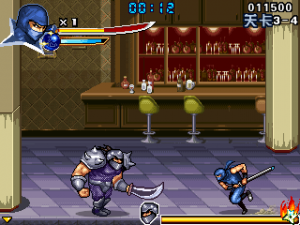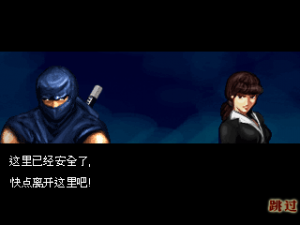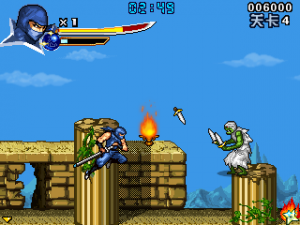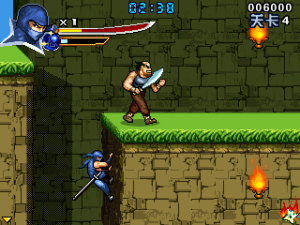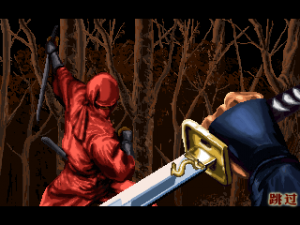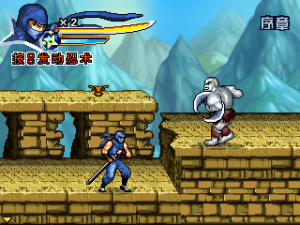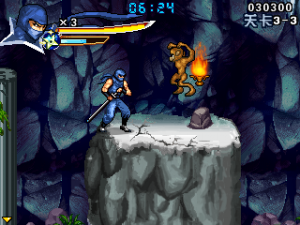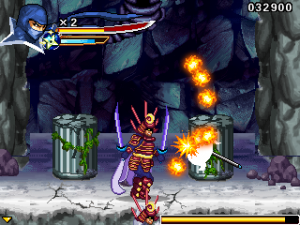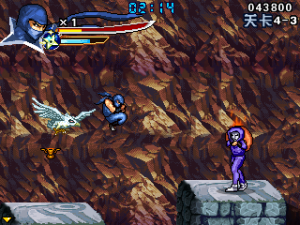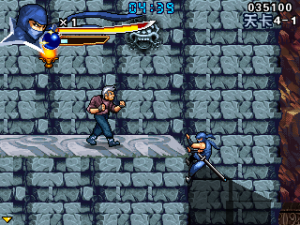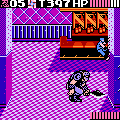- Ninja Gaiden (Arcade)
- Ninja Gaiden (NES)
- Ninja Gaiden II (NES)
- Ninja Gaiden III (NES)
- Ninja Gaiden Shadow
- Ninja Gaiden (Game Gear)
- Ninja Gaiden (Master System)
- Ninja Gaiden (Genesis)
- Ninja Gaiden (2004)
- Ninja Gaiden: Dragon Sword
- Ninja Gaiden II (2008)
- Ninja Gaiden 3 (2012)
- Yaiba: Ninja Gaiden Z
- Ninja Gaiden Old & New
- Ninja Gaiden: Miscellanous
- Masato Kato (Interview)
The Ninja Gaiden Trilogy (1988-1991 & 1995)
The Ninja Gaiden arcade game wasn’t that great, but at the same time as Strong Shima and his team worked on the brawler, Hideo Yoshizawa (who later made a transfer to Namco and created the Klonoa series) realized his own vision of a ninja’s crusade against demon hordes. By 1988, a lot of companies had already discovered that games on contemporary 8-bit home consoles needed a different approach than arcade games. In the coin-op business, short and tight games that manage to squeeze as many coins as possible out of customers in a short time were required. But the concept of drawing audiences through high-end presentation and make them lose all the time yet continuously spend more money didn’t quite apply to the technical limitations of the NES. Also, players at home usually spent at least fifty bucks on a single game, so they expected more content than they could get for a few quarters in the arcades. Therefore, a lot of franchises came out much richer in content on the weaker hardware, as can be seen with the NES adaptions of famous series such as Double Dragon and Ganbare Goemon.
Ninja Gaiden was no exception and underwent another conception as one of the best action side scrollers of its time, rather than mirroring the second-rate Double Dragon clone from the arcades. The following three games for the NES are regarded as the main trilogy of the old series, not only because later incarnations weren’t developed by Tecmo itself, but also because of their quality. These three games were also upgraded to the SNES as the Ninja Gaiden Trilogy in 1995 (called Ninja Ryūkenden Tomoe in Japan), which later provided the basis for the unlockable games in the Xbox Ninja Gaiden, while the original NES versions are available for the Wii via Virtual Console.
Not only did Tecmo deliver a series of fine action games, they actually went one step further and beefed it up with what is probably the most immersive and suspenseful storytelling ever seen in an 8-bit console game. The games were labeled as part of the “Tecmo Theater” series, and thus all the acts are linked through extensive cinematic cutscenes. Supported by a kick-ass soundtrack, these three gems can be considered must-plays for anyone who is into 2D action platformers. It was in these cut scenes where the game developed its cast of characters, who are introduced below.
Characters
Ryu Hayabusa
The hero of all the games and wielder of the Dragon Sword, he starts his adventures in America to take revenge for his father’s apparent murder.
A CIA agent helps Ryu on his mission and eventually becomes his love interest. She knows how to handle a gun, but still ends up getting kidnapped frequently.
Archaeologist and acquaintance of Ryu’s father. He discovered the strange demon statuette. What does he know about Joe Hayabusa’s fate?
A shady CIA agent and Irene’s superior. His goals seem to match with Ryu’s, but his methods are rather questionable.
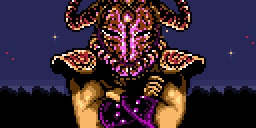
Bloody Malth
The cursed fighter who fought and supposedly killed Joe Hayabusa. He wields demonic power and has control over lightning.
The Jaquio
The evil mastermind. He plans to take over the world by releasing the power of an evil demon. Jaquio is actually just his title, Japanese for “Demon King”. His real name is Guardia de Mieux.
Ryu’s father, reportedly dead. The English version changed his name to Ken Hayabusa, probably because Joe seemed too much like an everyone’s name to Americans.
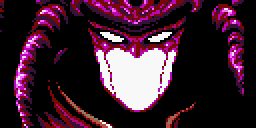
Ashtar
The villain of the second episode. He seeks to reactivate the Dark Sword of Chaos to continue the big evil scheme, in which the Jaquio now appears to have been a mere pawn.
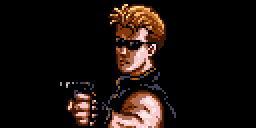
Robert T. Sturgeon
This commando type guy is a new ally to Ryu in the fight against Ashtar and his Dark Sword of Chaos.
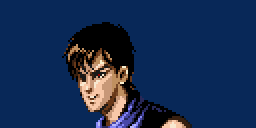
The Clone
A genetic copy of Ryu, who went out to kill Irene while posing as the hero, thus triggering Ryu’s third (but chronologically second) adventure.
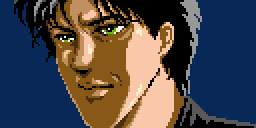
H.P. Clancy
A mysterious dude who seems to know something about Irene’s death and the strange biomechanical experiments she tried to investigate leading up to the third game.
Ninja Ryuukenden (忍者龍剣伝) / Ninja Gaiden / Shadow Warriors – NES, PC Engine, SNES, Mobile, Xbox, Wii (1988)
The basic plot in the very first home Ninja Gaiden is simple and rather stereotypical – a young Ninja goes out to seek revenge for the killing of his father, while the Jaquio’s evil plot to gain access to an ancient demonic power unfolds. But it is the style in which it is told that makes it so great. After watching the breathtaking introduction (which is still fantastic after all these years) and starting the game, you’ll soon notice that Tecmo once again didn’t reinvent the wheel. This time, the obvious role model was Castlevania. The most striking resemblance might be the reoccurring scene of the hero gazing at a (usually crumbling) castle from a faraway platform. (But then again, that might just be the dramatically most effective way to gaze at a crumbling castle, who knows. The Super Shinobi games, too, contain very similar scenes.) But there are also many corresponding enemy types, especially in the beginning, with the stupid birds being the most annoying. The secondary weapon system is also quite similar – each level is filled with various icons (lamps, spider webs, other random stuff) that act just like the candles in Castlevania, and dispense new weapons, ninjitsu points to use these weapons, or other power-ups. These are activated, of course, by pressing Up + Attack.
Contrary to the rather mediocre arcade game, Ninja Gaiden on the NES actually does a lot of things even better than Castlevania did. First, it’s a very fast game, as there aren’t many instances where you can just hold your position or slowly approach your enemies. Instead you have to jump over them, constantly move to get a good position against them, and smartly use your secondary weapons. Many of the weapons’ effects, seem to have been borrowed from Castlevania as well – most of the time you’ll be using shurikens, especially the boomerang-esque Windmill Shuriken. This one is extremely useful, since you can keep avoiding it to make it fly around the screen multiple times. Then you’ve got the Art of the Fire Wheel, which, much like Castlevania‘s axe, is used to attack enemies above. A new innovation is the Jump & Slash, which makes for a really cool spinning air attack, useful against enemies defending a platform you have to jump to. While it can completely murder bosses, it quickly draws your weapon points, since it replaces the standard jumping attack and isn’t used separately with Up + Attack like the other weapons.
Every weapon use costs 3 or 5 ninjitsu points, drawn from a maximum pool of 99 points. Although you also get 5 or 10 points for every “Spiritual Strength” item you collect, you can quickly run out of ammo – a stark contrast to Castlevania, where you can spam weapons continuously and defeat a good number of the bosses using only those. The last weapon is the Invincible Fire Wheel, which, as the name implies, makes you invincible for a certain time, with the drawback of deleting your current extra weapon. There are also items that simply bonus points, life recharge, and a time stopping hour glass to be found inside the “candles”.
But all the weapons and special items aside, Ninja Gaiden‘s greatest speciality is once again Ryu’s agility as a ninja. By jumping against a wall, he will cling on to it – unless there’s a ladder, you can’t climb directly up or downwards. Instead you have to jump off, and, if there’s another wall facing the first one, climb up by wall-jumping alternately. This wall bouncing technique has since become a staple of awesome action games everywhere.
Regardless of all these abilities, Ninja Gaiden still is a very hard game. As you move back and forth, enemies constantly respawn based on your position. If you happen to stand on the wrong spot, the same enemy will attack you again and again until you move on. This is especially dangerous when this spot happens to be the edge of a platform. Jumping carelessly will only get you hit more often, and since every enemy hit throws you back, you’ll usually get tossed into a pit. If you’re clinging to a wall, you won’t get knocked off, but in turn, you’re a sitting duck for enemy attacks. If you don’t know where the enemies spawn before you see them, it will often be already too late for you to react properly, so prepare yourself for a lot of memorization. At least almost all the normal enemies die from a single hit, so you don’t have to think about your following retreat while attacking. Thankfully, you’ve also got a limitless number of credits at your disposal, so unless you turn the game off out of frustration (or toss it out the window), the farthest you’ll get ever thrown back is the beginning of a stage, which is never too far away.
Until you reach Act 6, that is. This last part of the game consist of three long stages, all of them insanely difficult, especially the legendary Stage 6-2. After that, you have to fight three (!) bosses, the finally two without any extra weapons. And the best thing: If you lose any one of these three battles, you’re starting right back at the beginning of Stage 6-1. That’s right, no matter if you have to use a credit or 9 lives left, you can go through all three levels of hell again. And lose you will. Dozens of times. And even though the game memorizes which bosses you already beat (e.g. if you beat the first and lose to the second, on your next run you don’t need to fight the first one anymore), this last chapter has got to be one of the hardest goddamn challenges in any video game ever, and it’s the only occasion where any game in the series gets just downright unfair.
The animation is nothing special even for the NES, but what makes the visuals stand out (besides the awesome cutscenes) are the beautiful stages. They’re displayed in a slight angle, which gives a nice feeling of depth to the visuals. You’ll visit a lof of different locations, like a rainforest, mountains or the downtown of a city. Only towards the end it gets a bit monotonous with the last two acts mainly consisting of temple ruins.
A port of the game was released for the PC Engine only in Japan in 1992, but it contains English screen text as well as Chinese, selectable through a code (which makes sense when taking into account that the actual development of the port took place at a Chinese company). Visually, this version is simultaneously better and worse than the original game, while also strangely being easier but harder at the same time. The most noticeable changes are cosmetic, as the art direction is completely different from the NES game. Sometimes the graphics looks great, but in other occasions somewhat cheaply drawn, despite the superior technology. The worst offenders are the new parallax scrolling backgrounds. Not only is their scrolling choppy as hell, it was done wrong, with the far background passing by faster than the close one. But this version also has some cool new effects, like the screen turning grey when picking up the time stop item. The soundtrack has also been changed a lot, and the new music isn’t nearly as good.
There are some slight adjustments to the weapons system, too. Now you can keep your weapon during invincibility and after completing an act. On the flipside of the coin, collision detection is much more unforgiving, especially with bosses, and being caught by certain enemies while clinging to a wall can almost be regarded an instant kill. The last boss has become insanely difficult, with much more projectiles and really hard to predict behavior. Oh, and don’t try the Jump & Slash boss trick in this version.
Together with the other two NES games, Ninja Gaiden was altered once again for the Ninja Gaiden Trilogy on the SNES, but this time the changes are much more subtle. The graphical enhancements are limited to a wider color palette, which made the cut scenes look great, but the graphics during gameplay, especially the 2-frame animations, don’t stand up to any other SNES game and are simply disappointing from a technological standpoint. Besides that, there is also some subtle censorship – some depictions of a Star of David that were probably intended to be pentagrams in the first place have been edited out. (This is missing in the PCE port too, but not due to censorship but because of the overall graphical changes – that version also had a much larger and more recognizable pentagram added at another position.) Also deleted from all three games are the end credits, which led to the loss of the corresponding music tracks, too. The music itself is arguably superior to the NES version and uses the extended tracks from the OST CDs, but purists may prefer the simpler original mixes. The timing of the controls doesn’t seem to exactly match the NES version, but again, it’s much closer than the PC Engine port was. The best change is the inclusion of a password system, so you don’t have to start from the beginning every time you turn on the console.
In 2004, the game was shortened and re-arranged for another version on mobile phones, split into four episodes that had to be bought separately. The first episode consists of Ninja Gaiden‘s Act 1, with two expanded stages added before the boss to extend this very short portion of the original game. It controls quite poorly, as one would imagine. You use the special weapons by pressing down, making it impossible to duck. Tecmo USA kept advertising it on the official home page for a long time, but only one of the four episodes was ever released in English.
The Wii Virtual Console release has only one noticeable change: when you lose all your lives on the NES and it’s Game Over, the screen starts flickering in weird color schemes. Possibly in reaction to the Pokémon epilepsy incident that caused seizures for many Japanese kids during an episode of the animated series, this was toned down for the Virtual Console, which usually features unmodified emulations of the classics.
When Ninja Ryūkenden was first previewed in the Japanese gaming magazine “Famimaga” during 1988, the screenshots showed different early prototypes for the game. The level layout seems to have differed vastly between versions (one screenshot shows a fight against boss from stage 3 in the bar at the beginning). In some versions, Ryu’s suit was even colored red, like the player 2 character in the arcade game. The font and the icons for special weapons had undergone some transitions as well (thanks go to Chris Covell for this discovery).
Renzhe Longjianzhuan (忍者龙剑传) – Mobile (ca. 2010)
The Chinese mobile market always holds a lot of surprises in the form of officially licensed games, and among them is a remake of the first NES Ninja Gaiden. The in-game graphics are entirely new and look fairly pleasant, despite choppy animations. The cutscenes are a mixed bag – some of them are beautiful redrawn pieces, while others look like shoddily filtered NES graphics. The music is all midi renditions of the original game’s score.
If you can get over Ryu’s extremely floaty jumps, the game is surprisingly playable, considering that it is played with a cellphone keypad and most versions are for vertically oriented screens, neither of which makes much sense for this kind of game. There are at least a few versions with proper dimensions out there, but those lack in vertical viewing range due to the larger sprites. Finally, there are some super large versions for touch screen devices, which show enough in every direction, but have to be played with the virtual gamepad. To make things easier, Ryu has his improved climbing abilities from the sequels, so getting up walls is no problem. It seems all the extra weapons are there, although they’re not as evenly distributed. But what ultimately destroys this remake is the structure: The game has been split into several releases (at least two, possibly three, it seems) and each of them is bloated with a seemingly endless array of repetitive stages.
Comparison Screenshots – Gameplay
Comparison Screenshots: Cutscenes
Comparison Screenshots: Pentagrams
Comparison Screenshots: Castle Gazing
